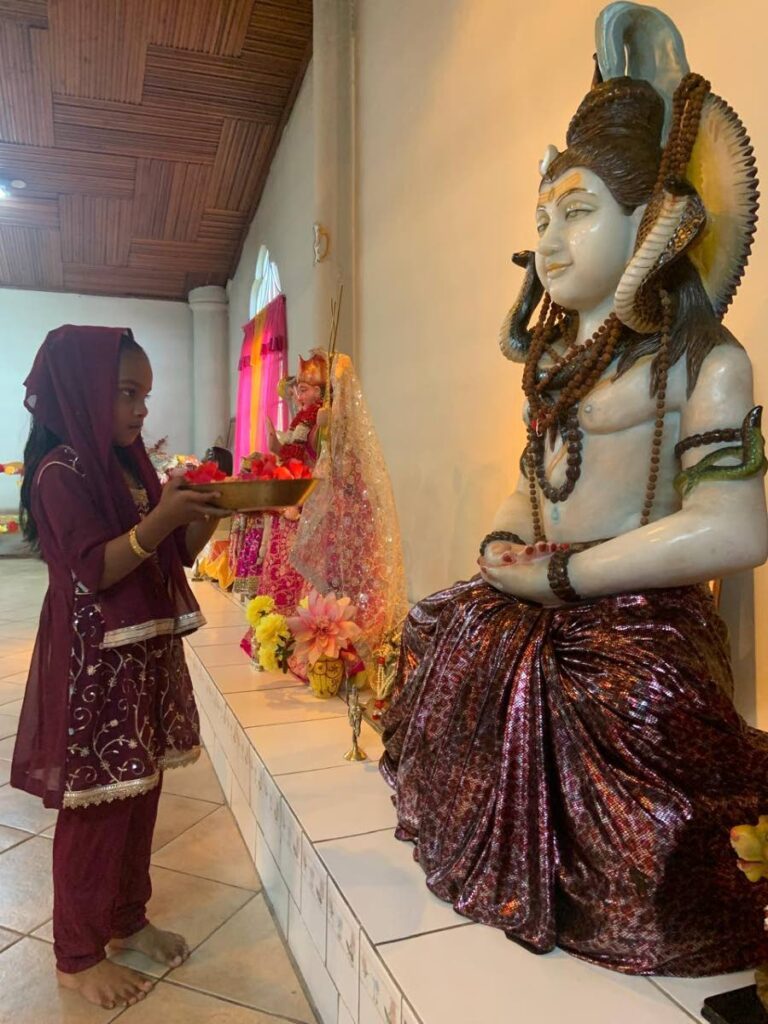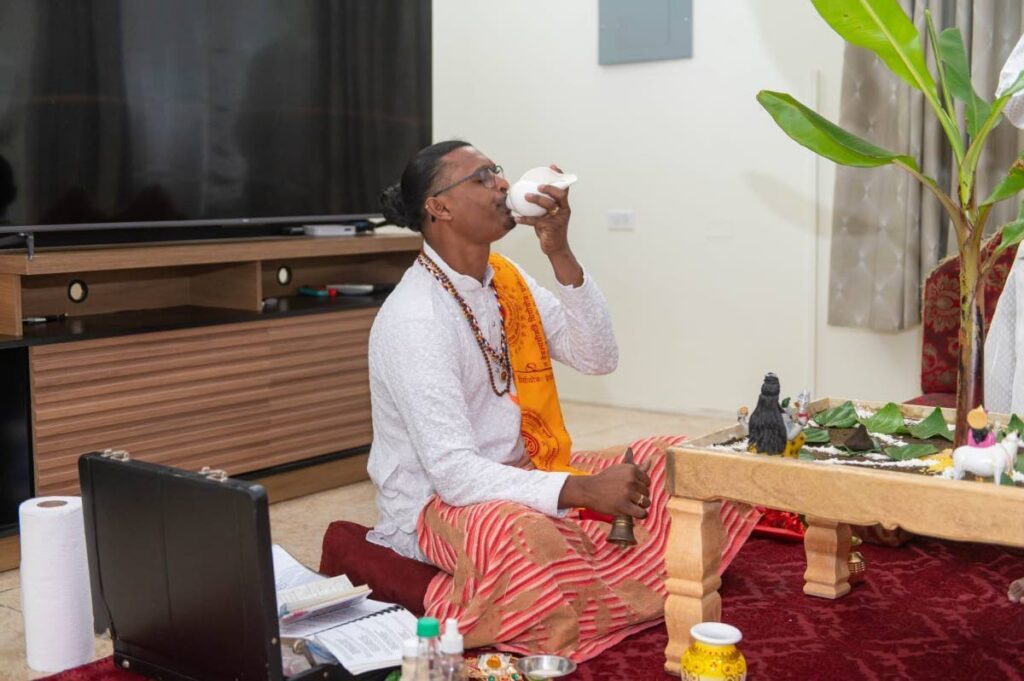Shivaratri a time for spiritual growth

BAVINA SOOKDEO
Hindus celebrate Maha Shivaratri, one of the most significant festivals dedicated to Lord Shiva, on February 26, from 6.12 pm to February 27, at 6.22 am.
Unlike many Hindu daytime festivals, Maha Shivaratri is celebrated at night – the 13th lunar night into the 14th day, just before the new moon in the Hindu month of Phalgun (from February 13-March 14).
Shiva is the third deity in the Hindu triumvirate (three godheads) which consists of Brahma (the creator), Vishnu (the preserver), and Shiva (the destroyer), pundit Sean Rambaran told Newsday. Rambaran, a pundit for six years, said many devotees journey to temples for all-night vigils. Those who cannot attend, perform their worship at home.
“Many people refer to Lord Shiva as the ‘Destroyer’ and often misinterpret it as something fearful, however, what he truly destroys are negative qualities such as negative karma, desire, greed, ego, attachment and anger. He does not destroy individuals but rather helps eliminate these negative traits within them, allowing for renewal and transformation. Through this process, Lord Shiva guides his devotees toward self-improvement and spiritual growth,” Rambaran said.
Shiva is depicted in many forms, each rich with meaning. He is often shown with a blue throat, an allusion to the legend of Samudra Manthan, where he consumed the deadly
halahal poison to save the universe, earning him the name
Neel Kanta (the blue-throated one).
Relating the Samudra Manthan story, Rambaran said “At one time, the devas (gods) and the
asuras (demons) sought to obtain Amrita, the nectar of immortality. Whoever consumed this nectar would become immortal. However, it could only be found in the Milky Ocean, where Lord Vishnu resides. To retrieve it, both the devas and asuras had to work together and churn the ocean. Positioning themselves on opposite sides, they began the great churning. As they churned, 14 different things emerged from the ocean, some beneficial and others dangerous. The most lethal of all was the halahal poison, a substance so deadly that it threatened to destroy all of creation.
"Both the devas and asuras were overwhelmed by its effects and cried out to Lord Shiva for help, as only he had the power to contain its destruction. Hearing their plea, Lord Shiva selflessly drank the poison to save the world. However, instead of swallowing it, he held it in his throat to prevent it from harming him or anyone else. This caused his throat to turn blue, earning him the name Neel Kanta, meaning 'the blue-throated one.'"
He said as the poison burnt within, intense heat radiated from his body. To cool him down, the
devas poured water over him, but it was not enough. They then applied curd (
dahee), ghee, honey, sugarcane juice, and other cooling substances. Even the serpent, Vasuki, was wrapped around his neck to help regulate the heat.
"This selfless act of Lord Shiva is one of the many reasons he is worshipped – as the saviour of humanity and the universe. His sacrifice during the churning of the ocean serves as a powerful symbol of his compassion, strength, and willingness to endure suffering for the well-being of all creation.”
Shiva represents a profound blend of symbolism and philosophy in Hinduism. Rambaran said his fair complexion signifies purity, while the crescent moon on his forehead represents his control over time, as time in Hinduism is measured by the moon.
“He is known as Maha Mrityunjaya, the great conqueror of death. His trishul (trident) symbolises the past, present, and future, as well as the three gunas (qualities) –
rajas (activity), tamas (inertia), and sattva (balance). The ash covering his body signifies his connection to cremation grounds, representing liberation and the transient nature of life," Rambaran said.

"His third eye embodies intellect and annihilation, both destructive and enlightening. The cobra around his neck illustrates his fearlessness, as it is a deadly creature he has tamed. The tiger skin on which he sits represents his mastery over desire and lust. His
damaru (kettle drum) signifies the cosmic sound from which creation emerged. He is also the lord of dance (Nataraja), symbolising cosmic rhythm and balance. Lastly, Nandi the bull, his vehicle, represents the four pillars of life – dharma (righteousness), artha (wealth), kama (desire), and moksha (liberation).”
As a great yogi, Shiva remains detached from worldly pleasures, reminding devotees to focus on spiritual pursuits.
“His relationship with his consort, Parvati, reflects the balance of masculine and feminine energies. In some depictions, Lord Shiva appears as Ardhanarishvara – half man, half woman – symbolising the inseparable bond between himself and Parvati.”
Maha Shivaratri is one of 12 Shivaratris observed in the Hindu calendar, but it holds special significance as the night when Shiva is believed to have performed the
Tandav – the cosmic dance of creation, preservation, and destruction.
On this sacred night, Hindus fast, perform pujas, seeking balance in mind, body, and soul. Through prayers and devotion, they strive for spiritual growth and inner peace.
Devotees observing Maha Shivaratri perform ling puja, making offerings in a specific order. Individuals must fast before making their offerings, which traditionally include, in sequence: water, milk, dahee, ghee, honey, sugar or sugarcane juice, water again.
Additional offerings are:
chandan (sandalwood paste), ashes , essence and incense, rice,
bael leaves, flowers,
aarti, prasad (sacred food offering,
jaap (chanting of mantras 108 times),
havan (fire offering – optional)
All offerings are accompanied by the recitation of Om Namah Shivaya.
How is this Hindu god relevant to this time?
Rambaran said, “Lord Shiva remains deeply relevant, as those who pray to him with full faith, trust, love, and devotion may cultivate qualities such as fearlessness, simplicity, meditation, universal love, patience, and compassion. He is widely worshipped across the world, and through sincere devotion, his followers can embody these virtues, ultimately becoming better individuals.”
He said the lessons of Shiva include “detachment from materialism, balance in life, and the pursuit of inner peace and spiritual awakening.”
To devotees he says, “As individuals, we should strive for continuous transformation, aiming to be better than we were yesterday. Let God lead the way, and as devotees, we should follow with faith and humility. Before we seek to change a country or a community, we must first look within, engage in self-reflection, and work on bettering ourselves. By embracing positivity and treating others as we wish to be treated, we can create a more compassionate and harmonious world.”

Comments
"Shivaratri a time for spiritual growth"